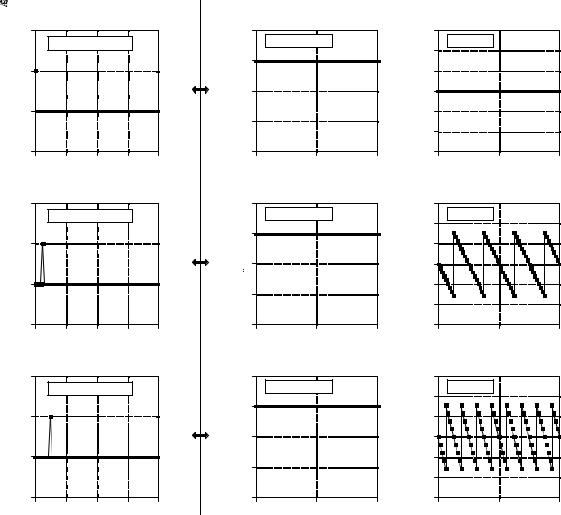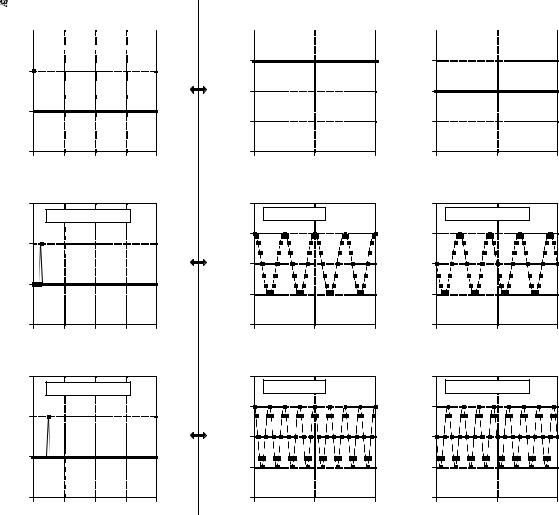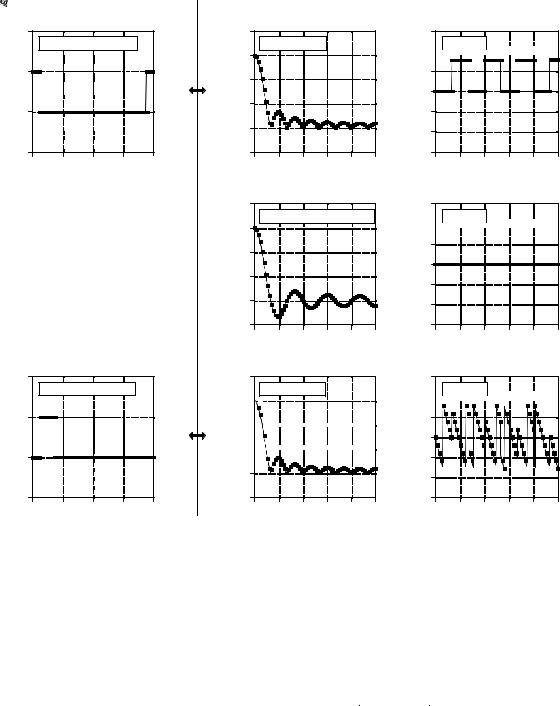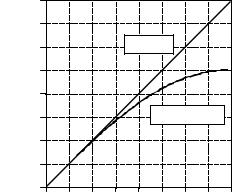

CHAPTER
Fourier Transform Pairs
11
For every time domain waveform there is a corresponding frequency domain waveform, and vice versa. For example, a rectangular pulse in the time domain coincides with a sinc function [i.e., sin(x)/x] in the frequency domain. Duality provides that the reverse is also true; a rectangular pulse in the frequency domain matches a sinc function in the time domain. Waveforms that correspond to each other in this manner are called Fourier transform pairs. Several common pairs are presented in this chapter.
Delta Function Pairs
For discrete signals, the delta function is a simple waveform, and has an equally simple Fourier transform pair. Figure 11-1a shows a delta function in the time domain, with its frequency spectrum in (b) and (c). The magnitude is a constant value, while the phase is entirely zero. As discussed in the last chapter, this can be understood by using the expansion/compression property. When the time domain is compressed until it becomes an impulse, the frequency domain is expanded until it becomes a constant value.
In (d) and (g), the time domain waveform is shifted four and eight samples to the right, respectively. As expected from the properties in the last chapter, shifting the time domain waveform does not affect the magnitude, but adds a linear component to the phase. The phase signals in this figure have not been unwrapped, and thus extend only from -B to B. Also notice that the horizontal axes in the frequency domain run from -0.5 to 0.5. That is, they show the negative frequencies in the spectrum, as well as the positive ones. The negative frequencies are redundant information, but they are often included in DSP graphs and you should become accustomed to seeing them.
Figure 11-2 presents the same information as Fig. 11-1, but with the frequency domain in rectangular form. There are two lessons to be learned here. First, compare the polar and rectangular representations of the
209

210 |
The Scientist and Engineer's Guide to Digital Signal Processing |
Time Domain
|
2 |
|
|
|
|
|
|
a. Impulse at x[0] |
|
||
Amplitude |
1 |
|
|
|
|
0 |
|
|
|
|
|
|
|
|
|
|
|
|
-1 |
|
|
|
|
|
0 |
16 |
32 |
48 |
643 |
|
|
Sample number |
|
||
|
2 |
|
|
|
|
|
|
d. Impulse at x[4] |
|
||
Amplitude |
1 |
|
|
|
|
0 |
|
|
|
|
|
|
|
|
|
|
|
|
-1 |
|
|
|
|
|
0 |
16 |
32 |
48 |
643 |
|
|
Sample number |
|
||
|
2 |
|
|
|
|
|
|
g. Impulse at x[8] |
|
||
Amplitude |
1 |
|
|
|
|
0 |
|
|
|
|
|
|
|
|
|
|
|
|
-1 |
|
|
|
|
|
0 |
16 |
32 |
48 |
643 |
|
|
Sample number |
|
||
|
|
|
Frequency Domain |
|
|||
|
2 |
b. Magnitude |
|
|
6 |
c. Phase |
|
|
|
|
|
4 |
|
||
|
|
|
|
|
|
|
|
Amplitude |
1 |
|
|
(radians)Phase |
|
|
|
|
|
|
2 |
|
|
||
|
|
|
|
|
|
|
|
|
0 |
|
|
|
0 |
|
|
|
|
|
|
|
-2 |
|
|
|
-1 |
|
|
|
|
|
|
|
|
|
|
|
-4 |
|
|
|
-2 |
|
|
|
-6 |
|
|
|
-0.5 |
0 |
0.5 |
|
-0.5 |
0 |
0.5 |
|
|
Frequency |
|
|
|
Frequency |
|
|
2 |
e. Magnitude |
|
|
6 |
f. Phase |
|
|
|
|
|
4 |
|
||
|
|
|
|
|
|
|
|
Amplitude |
1 |
|
|
(radians)Phase |
|
|
|
|
|
|
2 |
|
|
||
|
|
|
|
|
|
|
|
|
0 |
|
|
|
0 |
|
|
|
|
|
|
|
-2 |
|
|
|
-1 |
|
|
|
|
|
|
|
|
|
|
|
-4 |
|
|
|
-2 |
|
|
|
-6 |
|
|
|
-0.5 |
0 |
0.5 |
|
-0.5 |
0 |
0.5 |
|
|
Frequency |
|
|
|
Frequency |
|
|
2 |
h. Magnitude |
|
|
6 |
i. Phase |
|
|
|
|
|
4 |
|
||
|
|
|
|
|
|
|
|
|
1 |
|
|
Phase (radians) |
|
|
|
Amplitude |
|
|
|
2 |
|
|
|
0 |
|
|
0 |
|
|
||
|
|
|
-2 |
|
|
||
-1 |
|
|
|
|
|
||
|
|
|
|
|
|
|
|
|
|
|
|
|
-4 |
|
|
|
-2 |
|
|
|
-6 |
|
|
|
-0.5 |
0 |
0.5 |
|
-0.5 |
0 |
0.5 |
|
|
Frequency |
|
|
|
Frequency |
|
FIGURE 11-1
Delta function pairs in polar form. An impulse in the time domain corresponds to a constant magnitude and a linear phase in the frequency domain.
frequency domains. As is usually the case, the polar form is much easier to understand; the magnitude is nothing more than a constant, while the phase is a straight line. In comparison, the real and imaginary parts are sinusoidal oscillations that are difficult to attach a meaning to.
The second interesting feature in Fig. 11-2 is the duality of the DFT. In the conventional view, each sample in the DFT's frequency domain corresponds to a sinusoid in the time domain. However, the reverse of this is also true, each sample in the time domain corresponds to sinusoids in the frequency domain. Including the negative frequencies in these graphs allows the duality property to be more symmetrical. For instance, Figs. (d), (e), and

|
|
|
|
Chapter 11Fourier Transform Pairs |
211 |
||||||||
|
Time Domain |
|
|
|
Frequency Domain |
||||||||
2 |
|
|
|
2 |
|
|
|
|
2 |
|
|
|
|
|
|
|
|
|
|
|
|
|
|||||
|
|
|
|
|
|
b. Real Part |
|
|
|
c. Imaginary part |
|
||
|
|
a. Impulse at x[0] |
|
||||||||||
|
|
|
|
|
|
|
|
|
|
|
|
|
|
|
|
|
|
|
|
|
1 |
|
|
|
1 |
|
|
Amplitude |
1 |
|
|
|
|
Amplitude |
|
|
|
Amplitude |
|
|
|
|
|
|
|
|
0 |
|
|
0 |
|
|
|||
0 |
|
|
|
|
|
|
|
|
|
|
|||
|
|
|
|
|
|
|
|
|
|
|
|
|
|
|
|
|
|
|
|
|
-1 |
|
|
|
-1 |
|
|
|
-1 |
|
|
|
|
|
-2 |
|
|
|
-2 |
|
|
|
0 |
16 |
32 |
48 |
643 |
|
-0.5 |
0 |
0.5 |
|
-0.5 |
0 |
0.5 |
|
|
Sample number |
|
|
|
Frequency |
|
|
|
Frequency |
|
||
|
2 |
|
|
|
|
|
2 |
e. Real Part |
|
|
2 |
f. Imaginary part |
|
|
|
d. Impulse at x[4] |
|
|
|
|
|
|
|
||||
|
|
|
|
|
|
|
1 |
|
|
|
1 |
|
|
Amplitude |
1 |
|
|
|
|
Amplitude |
|
|
|
Amplitude |
|
|
|
|
|
|
|
|
0 |
|
|
0 |
|
|
|||
0 |
|
|
|
|
|
|
|
|
|
|
|||
|
|
|
|
|
|
|
|
|
|
|
|
|
|
|
|
|
|
|
|
|
-1 |
|
|
|
-1 |
|
|
|
-1 |
|
|
|
|
|
-2 |
|
|
|
-2 |
|
|
|
0 |
16 |
32 |
48 |
643 |
|
-0.5 |
0 |
0.5 |
|
-0.5 |
0 |
0.5 |
|
|
Sample number |
|
|
|
Frequency |
|
|
|
Frequency |
|
||
|
2 |
|
|
|
|
|
2 |
h. Real Part |
|
|
2 |
i. Imaginary part |
|
|
|
g. Impulse at x[8] |
|
|
|
|
|
|
|
||||
|
|
|
|
|
|
|
1 |
|
|
|
1 |
|
|
Amplitude |
1 |
|
|
|
|
Amplitude |
|
|
|
Amplitude |
|
|
|
|
|
|
|
|
0 |
|
|
0 |
|
|
|||
0 |
|
|
|
|
|
|
|
|
|
|
|||
|
|
|
|
|
|
|
|
|
|
|
|
|
|
|
|
|
|
|
|
|
-1 |
|
|
|
-1 |
|
|
|
-1 |
|
|
|
|
|
-2 |
|
|
|
-2 |
|
|
|
0 |
16 |
32 |
48 |
643 |
|
-0.5 |
0 |
0.5 |
|
-0.5 |
0 |
0.5 |
|
|
Sample number |
|
|
|
Frequency |
|
|
|
Frequency |
|
||
FIGURE 11-2
Delta function pairs in rectangular form. Each sample in the time domain results in a cosine wave in the real part, and a negative sine wave in the imaginary part of the frequency domain.
(f) show that an impulse at sample number four in the time domain results in four cycles of a cosine wave in the real part of the frequency spectrum, and four cycles of a negative sine wave in the imaginary part. As you recall, an impulse at sample number four in the real part of the frequency spectrum results in four cycles of a cosine wave in the time domain. Likewise, an impulse at sample number four in the imaginary part of the frequency spectrum results in four cycles of a negative sine wave being added to the time domain wave.
As mentioned in Chapter 8, this can be used as another way to calculate the DFT (besides correlating the time domain with sinusoids). Each sample in the time domain results in a cosine wave being added to the real part of the

212 |
The Scientist and Engineer's Guide to Digital Signal Processing |
frequency domain, and a negative sine wave being added to the imaginary part. The amplitude of each sinusoid is given by the amplitude of the time domain sample. The frequency of each sinusoid is provided by the sample number of the time domain point. The algorithm involves: (1) stepping through each time domain sample, (2) calculating the sine and cosine waves that correspond to each sample, and (3) adding up all of the contributing sinusoids. The resulting program is nearly identical to the correlation method (Table 8-2), except that the outer and inner loops are exchanged.
The Sinc Function
Figure 11-4 illustrates a common transform pair: the rectangular pulse and the sinc function (pronounced “sink”). The sinc function is defined as: sinc(a) ' sin(Ba)/ (Ba) , however, it is common to see the vague statement: "the sinc function is of the general form: sin(x)/x ." In other words, the sinc is a sine wave that decays in amplitude as 1/x. In (a), the rectangular pulse is symmetrically centered on sample zero, making one-half of the pulse on the right of the graph and the other one-half on the left. This appears to the DFT as a single pulse because of the time domain periodicity. The DFT of this signal is shown in (b) and (c), with the unwrapped version in (d) and (e).
First look at the unwrapped spectrum, (d) and (e). The unwrapped magnitude is an oscillation that decreases in amplitude with increasing frequency. The phase is composed of all zeros, as you should expect for a time domain signal that is symmetrical around sample number zero. We are using the term unwrapped magnitude to indicate that it can have both positive and negative values. By definition, the magnitude must always be positive. This is shown in (b) and (c) where the magnitude is made all positive by introducing a phase shift of B at all frequencies where the unwrapped magnitude is negative in (d).
In (f), the signal is shifted so that it appears as one contiguous pulse, but is no longer centered on sample number zero. While this doesn't change the magnitude of the frequency domain, it does add a linear component to the phase, making it a jumbled mess. What does the frequency spectrum look like as real and imaginary parts ? Too confusing to even worry about.
An N point time domain signal that contains a unity amplitude rectangular pulse M points wide, has a DFT frequency spectrum given by:
EQUATION 11-1 |
|
|
|
|
DFT spectrum of a rectangular pulse. In this |
|
|
|
|
equation, N is the number of points in the |
|
' / |
|
/ |
time domain signal, all of which have a value |
Mag X [ k ] |
sin(BkM / N ) |
||
of zero, except M adjacent points that have a |
||||
|
|
|||
value of one. The frequency spectrum is |
|
0 |
|
0 |
|
0 |
sin(Bk /N ) |
0 |
|
contained in X[k] , where k runs from 0 to |
|
0 |
0 |
|
|
|
|
|
N/2. To avoid the division by zero, use X[0] ' M. The sine function uses radians, not degrees. This equation takes into account that the signal is aliased.

Time Domain
|
2 |
|
|
|
|
|
|
a. Rectangular pulse |
|
||
Amplitude |
1 |
|
|
|
|
0 |
|
|
|
|
|
|
|
|
|
|
|
|
-1 |
|
|
|
|
|
0 |
32 |
64 |
96 |
1287 |
|
|
Sample number |
|
||
|
2 |
|
|
|
|
|
|
f. Rectangular pulse |
|
||
Amplitude |
1 |
|
|
|
|
0 |
|
|
|
|
|
|
|
|
|
|
|
|
-1 |
|
|
|
|
|
0 |
32 |
64 |
96 |
1287 |
Sample number
Chapter 11Fourier Transform Pairs |
213 |
Frequency Domain
|
20 |
|
|
b. Magnitude |
|
Amplitude |
15 |
|
10 |
||
|
||
|
5 |
0 |
-5
0 |
0.1 |
0.2 |
0.3 |
0.4 |
0.5 |
Frequency
20
d. Unwrapped Magnitude
|
15 |
Amplitude |
10 |
5 |
|
|
0
-5
0 |
0.1 |
0.2 |
0.3 |
0.4 |
0.5 |
Frequency
6
c. Phase 
4 



























(radians) |
0 |
|
|
|
|
|
|
2 |
|
|
|
|
|
Phase |
-2 |
|
|
|
|
|
|
|
|
|
|
|
|
|
-4 |
|
|
|
|
|
|
-6 |
|
|
|
|
|
|
0 |
0.1 |
0.2 |
0.3 |
0.4 |
0.5 |
Frequency
or
6
e. Phase 
4 



























(radians) |
2 |
|
|
|
|
|
|
|
|
|
|
|
|
Phase |
0 |
|
|
|
|
|
-2 |
|
|
|
|
|
|
|
|
|
|
|
|
|
|
-4 |
|
|
|
|
|
|
-6 |
|
|
|
|
|
|
0 |
0.1 |
0.2 |
0.3 |
0.4 |
0.5 |
Frequency
Amplitude
20
g. Magnitude
15 


10 



























5 



























0 |
-5
0 |
0.1 |
0.2 |
0.3 |
0.4 |
0.5 |
Frequency
6
h. Phase 
4 



























(radians) |
2 |
|
|
|
|
|
|
|
|
|
|
|
|
Phase |
0 |
|
|
|
|
|
-2 |
|
|
|
|
|
|
|
|
|
|
|
|
|
|
-4 |
|
|
|
|
|
|
-6 |
|
|
|
|
|
|
0 |
0.1 |
0.2 |
0.3 |
0.4 |
0.5 |
Frequency
FIGURE 11-3
DFT of a rectangular pulse. A rectangular pulse in one domain corresponds to a sinc function in the other domain.
Alternatively, the DTFT can be used to express the frequency spectrum as a fraction of the sampling rate, f:
EQUATION 11-2
Equation 11-1 rewritten in terms of the sampling frequency. The parameter, f , is the fraction of the sampling rate, running continiously from 0 to 0.5. To avoid the division by zero, use Mag X(0) ' M .
Mag X ( f ) ' / |
sin(Bf M ) |
/ |
|
||
0 |
|
0 |
0 |
sin(Bf ) |
0 |
0 |
0 |
In other words, Eq. 11-1 provides N/2 % 1 samples in the frequency spectrum, while Eq. 11-2 provides the continuous curve that the samples lie on. These

214 |
The Scientist and Engineer's Guide to Digital Signal Processing |
equations only provide the magnitude. The phase is determined solely by the left-right positioning of the time domain waveform, as discussed in the last chapter.
Notice in Fig. 11-3b that the amplitude of the oscillation does not decay to zero before a frequency of 0.5 is reached. As you should suspect, the waveform continues into the next period where it is aliased. This changes the shape of the frequency domain, an effect that is included in Eqs. 11-1 and 11-2.
It is often important to understand what the frequency spectrum looks like when aliasing isn't present. This is because discrete signals are often used to represent or model continuous signals, and continuous signals don't alias. To remove the aliasing in Eqs. 11-1 and 11-2, change the denominators from sin (Bk M / N ) to BkM / N , and sin (Bf ) to Bf , respectively. Figure 11-4 shows the significance of this. The quantity Bf can only run from 0 to 1.5708, since f can only run from 0 to 0.5. Over this range there isn't much difference between sin (Bf ) and Bf . At zero frequency they have the same value, and at a frequency of 0.5 there is only about a 36% difference. Without aliasing, the curve in Fig. 11-3b would show a slightly lower amplitude near the right side of the graph, and no change near the left side.
When the frequency spectrum of the rectangular pulse is not aliased (because the time domain signal is continuous, or because you are ignoring the aliasing), it is of the general form: sin (x)/ x , i.e., a sinc function. For continuous signals, the rectangular pulse and the sinc function are Fourier transform pairs. For discrete signals this is only an approximation, with the error being due to aliasing.
The sinc function has an annoying problem at x ' 0 , where sin (x)/x becomes zero divided by zero. This is not a difficult mathematical problem; as x becomes very small, sin (x) approaches the value of x (see Fig. 11-4).
FIGURE 11-4
Comparing x and sin(x). The functions: y(x) ' x, and y(x) ' sin (x) are similar for small values of x, and only differ by about 36% at 1.57 (B/2). This describes how aliasing distorts the frequency spectrum of the rectangular pulse from a pure sinc function.
|
1.6 |
|
|
|
|
|
|
|
|
|
1.4 |
|
|
|
|
|
|
|
|
|
1.2 |
|
|
|
y(x) = x |
|
|
|
|
y(x) |
1 |
|
|
|
|
|
|
|
|
0.8 |
|
|
|
|
|
|
|
|
|
|
|
|
|
|
|
|
|
|
|
|
0.6 |
|
|
|
|
y(x) = sin(x) |
|
||
|
0.4 |
|
|
|
|
|
|
|
|
|
0.2 |
|
|
|
|
|
|
|
|
|
0 |
|
|
|
|
|
|
|
|
|
0.0 |
0.2 |
0.4 |
0.6 |
0.8 |
1.0 |
1.2 |
1.4 |
1.6 |
|
|
|
|
|
x |
|
|
|
|
